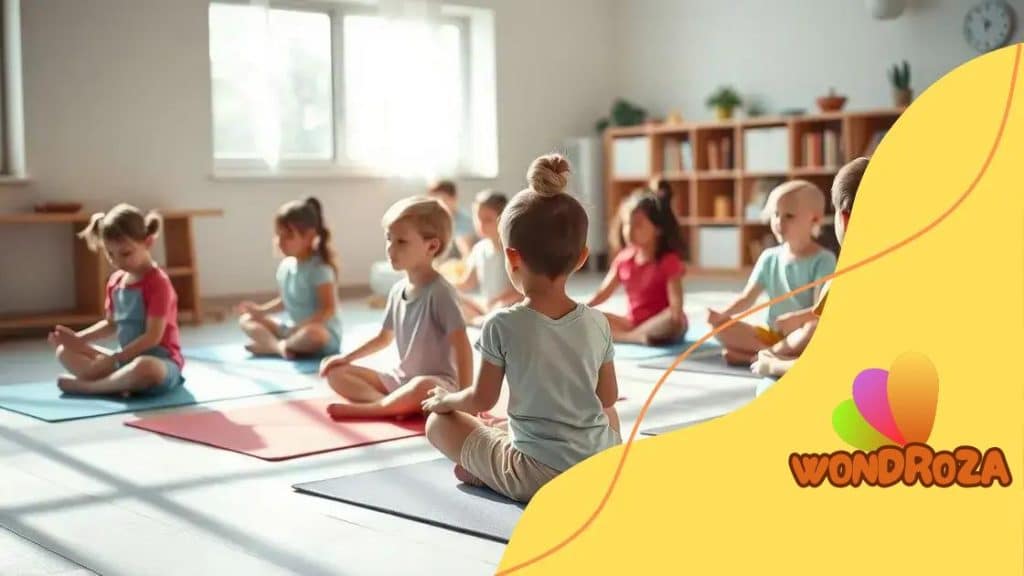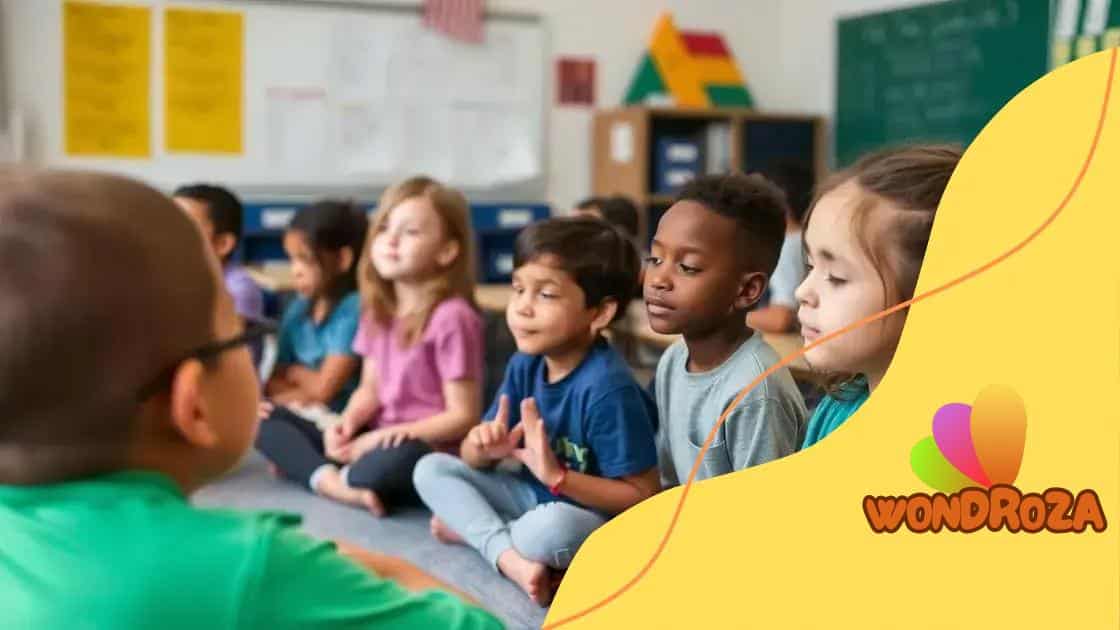The role of mindfulness practices in school curriculums

The role of mindfulness practices in school curriculums improves student focus, reduces stress, and fosters emotional well-being, creating a more positive learning environment.
The role of mindfulness practices in school curriculums is gaining attention for its potential to enhance student focus and emotional well-being. Many educators are curious about how these practices can reshape the learning environment and foster a positive atmosphere.
Understanding mindfulness and its benefits
Understanding mindfulness is essential when discussing its role in education. Mindfulness involves paying attention to the present moment with an open and non-judgmental attitude. This practice has gained momentum in schools as a powerful tool for improving mental health and enhancing focus among students.
When educators introduce mindfulness in the classroom, students experience several benefits. These benefits include increased emotional regulation and improved attention spans, which can lead to better academic performance.
Key Benefits of Mindfulness
Integrating mindfulness into educational settings cultivates a more positive learning atmosphere. Here are some key advantages:
- Enhances concentration and focus.
- Reduces anxiety and stress levels.
- Promotes emotional well-being.
- Fosters empathy and social connections.
Research has shown that students who practice mindfulness frequently exhibit better behavior and social skills. They become more aware of their feelings and thoughts, which allows them to respond more thoughtfully in challenging situations.
Additionally, mindfulness encourages resilience. By learning to navigate their emotions, students build coping strategies that can help them manage stress more effectively. As they engage in mindfulness practices, they also develop a sense of community within the classroom.
Integrating mindfulness into daily routines
Integrating mindfulness into daily routines is crucial for fostering a calm and focused environment in schools. When students practice mindfulness regularly, they learn to manage stress and improve their concentration.
Creating a mindful routine can start with simple, intentional practices. For example, teachers can incorporate short mindfulness exercises at the beginning of the day. This setting allows students to gather their thoughts and prepare for learning.
Practical Strategies for Daily Mindfulness
To successfully integrate mindfulness into the school day, consider these practical strategies:
- Begin the day with a few minutes of deep breathing.
- Encourage students to express gratitude through journal entries.
- Incorporate mindful movement, such as yoga, into physical education.
- Schedule moments of silence before tests or important activities.
Another effective approach is to create a mindfulness corner in the classroom. This space can include calming visuals, a cozy seating area, or materials for art. Allowing students to retreat to this area when they feel overwhelmed can help them regain focus and calmness.
Teachers and staff can also model mindfulness by practicing it themselves. When educators demonstrate mindful behavior, students are more likely to engage in similar practices. This creates a culture of mindfulness that pervades the entire school. Open discussions about mindfulness among students can inspire collaboration and peer support.
Impact of mindfulness on student behavior

The impact of mindfulness on student behavior is profound and wide-reaching. When students engage in mindfulness practices, they often experience positive changes in how they act and interact with others. Studies show that mindfulness can help reduce impulsivity and promote patience.
One significant effect of mindfulness is improved emotional regulation. Students learn to pause and recognize their feelings instead of reacting immediately. This skill is valuable during conflicts and stressful situations. For instance, classrooms with mindfulness programs often report fewer incidents of bullying.
Behavioral Changes Linked to Mindfulness
Implementing mindfulness leads to various behavioral improvements, such as:
- Increased self-control among students.
- Enhanced ability to focus on tasks.
- Lower levels of anxiety and stress.
- More positive interactions with peers and teachers.
As students become more mindful, they also develop greater empathy. By understanding their emotions, they can better relate to the feelings of others. This shift nurtures a more supportive classroom community.
Additionally, teachers who practice mindfulness report feeling less stressed and more engaged. This positive change in educators creates a ripple effect, encouraging students to adopt similar mindful behaviors. When teachers model calmness and patience, students are more likely to follow their example.
Evaluating mindfulness programs in schools
Evaluating mindfulness programs in schools is essential to understand their effectiveness and impact on student well-being. Many schools adopt these programs, but assessing their success involves more than just initial enthusiasm. Schools need to measure specific outcomes to determine if these practices benefit students effectively.
One approach to evaluation is through surveys and feedback from both students and teachers. When schools conduct regular check-ins, they can gather insights about how mindfulness is perceived and experienced in the classroom.
Key Metrics for Evaluation
To assess the impact of mindfulness programs, consider these six key metrics:
- Improvement in student focus and attention spans.
- Reduction in stress and anxiety levels.
- Changes in student behavior, such as fewer conflicts.
- Enhanced emotional regulation and resilience.
- Increased self-reported satisfaction with school.
- Feedback from parents and community members.
Schools might also look at academic performance data to see if there are improvements in grades or attendance. This data can provide a clear picture of mindfulness’s role in supporting educational goals.
Another important aspect is to observe classroom dynamics. Teachers can note whether mindfulness practices foster a more positive classroom environment. This atmosphere encourages teamwork and collaboration among students.
Future of mindfulness in education
The future of mindfulness in education looks promising as more schools recognize its benefits. As educators embrace this practice, we can expect to see significant changes in how students learn and interact within the classroom.
One key trend is the integration of mindfulness into daily lessons. Teachers are finding creative ways to incorporate mindfulness exercises that fit seamlessly into existing curricula. This approach not only helps students focus but also enhances their emotional intelligence.
Emerging Practices and Innovations
Schools are exploring various innovative practices to make mindfulness a core part of the educational experience. Some of these include:
- Mindfulness-based curricula that teach relaxation and attention skills.
- Partnerships with mental health professionals to provide comprehensive support.
- Workshops for teachers to develop their own mindfulness practices.
- Utilizing technology, such as apps and online programs, to facilitate mindfulness activities.
As mindfulness becomes more embedded in education, we can anticipate the development of specific training programs for educators. These programs will equip teachers with the skills needed to lead mindfulness activities effectively.
Furthermore, research into the long-term effects of mindfulness in schools is expected to grow. Understanding how these practices impact student well-being and academic success will help refine mindfulness programs. With increasing evidence, schools can advocate for resources that support tranquility and focus among students.
FAQ – Frequently Asked Questions about Mindfulness in Education
How does mindfulness improve student focus?
Mindfulness practices help students learn to concentrate on the present moment, reducing distractions and enhancing their ability to focus on schoolwork.
What are some common mindfulness activities for schools?
Common activities include deep breathing exercises, guided meditations, and mindful movement, such as yoga.
Can mindfulness reduce student stress?
Yes, studies show that regular mindfulness practice can lower stress and anxiety levels among students, promoting better emotional health.
How can teachers integrate mindfulness into their lessons?
Teachers can integrate mindfulness by starting the day with short activities, creating a mindfulness corner, or utilizing apps that guide students through mindfulness practices.





